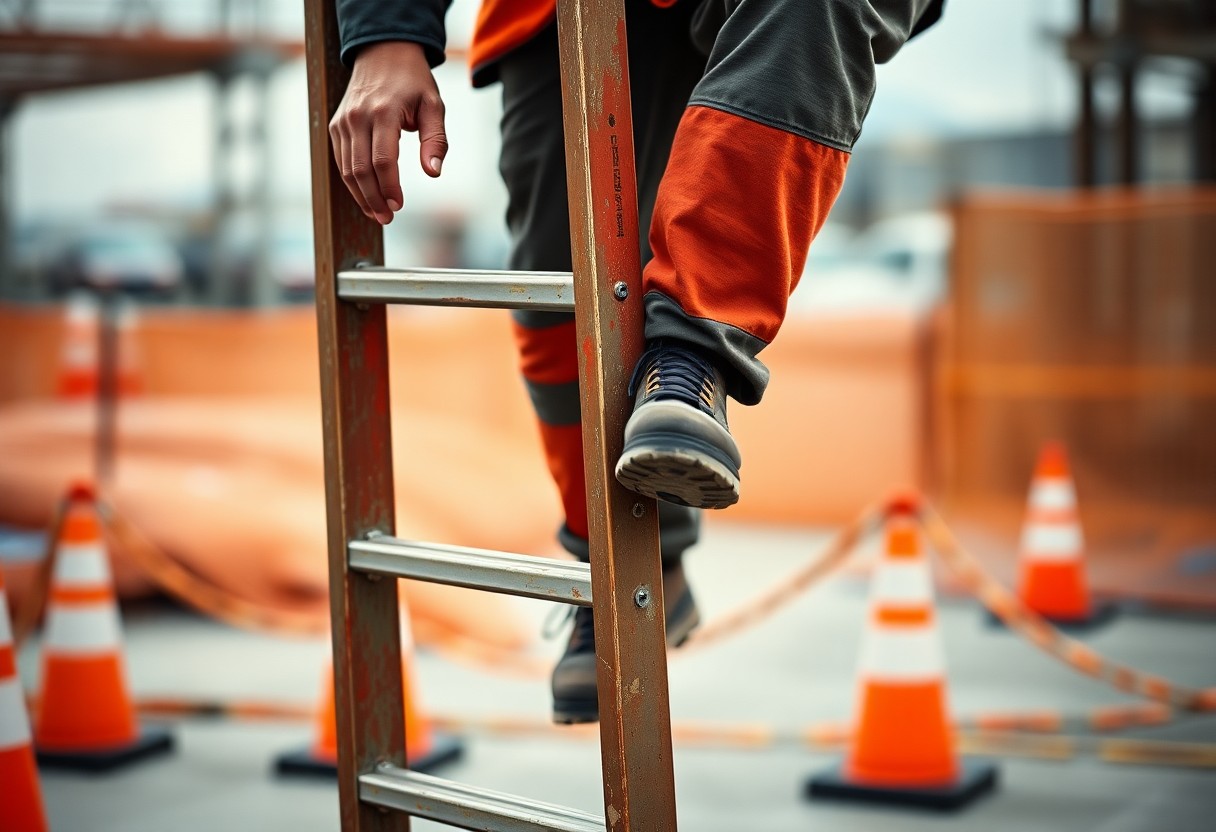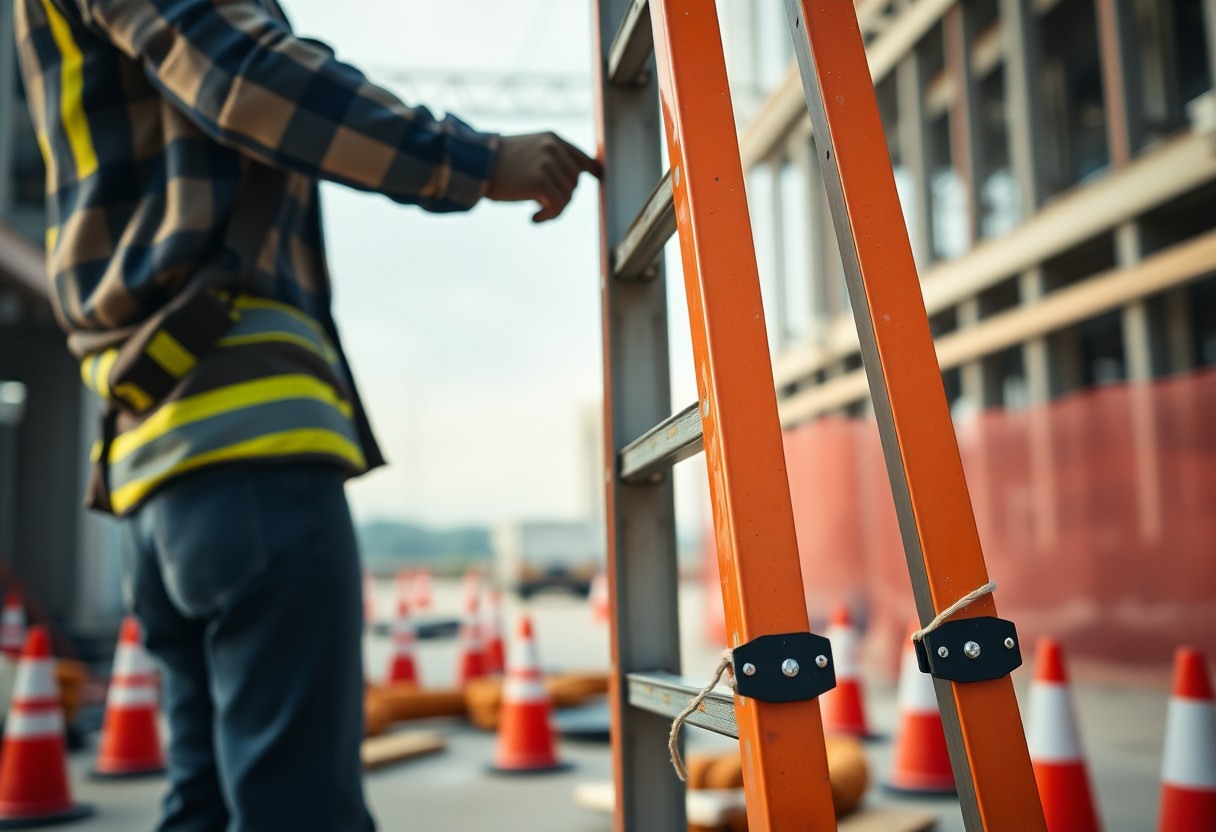Ladders can be your best friend for reaching high places, but using them incorrectly can lead to serious injuries. To ensure your safety while climbing, always maintain three points of contact—two hands and one foot, or two feet and one hand—on the ladder at all times. This technique provides stability and helps prevent falls. Before you start your ascent, make sure your ladder is on a stable surface and free from obstacles. Following these guidelines will make your ladder use safer and more efficient.

Key Takeaways:
- Always maintain three points of contact when using a ladder, which can include two feet and one hand or two hands and one foot.
- Ensure the ladder is stable and on a flat, stable surface before climbing, and avoid reaching too far to minimize the risk of losing balance.
- Inspect the ladder for any damage or wear before use, and do not use it if it is compromised in any way.
The Principle of Three Points of Contact
Using a ladder safely hinges on the principle of maintaining three points of contact at all times. This involves keeping two feet and one hand, or two hands and one foot, securely engaged with the ladder. By adhering to this guideline, you distribute your weight appropriately and enhance your stability, drastically reducing the risk of slipping or falling.
What Are the Three Points of Contact?
The three points of contact refer to the stable connection you create with the ladder. Typically, this means placing both feet on the rungs while using one hand to hold the ladder, or vice versa. This configuration ensures that you have a firm grip and balanced footing during your ascent or descent.
Why Three Points of Contact Matter
Maintaining three points of contact significantly lowers the risk of accidents while using a ladder. Studies show that falls are responsible for more than 300,000 injuries each year, many of which could be prevented by following this simple practice. A solid grip and stable footing allow you to focus on the task at hand rather than worrying about losing your balance.
When you adhere to the principle of three points of contact, it creates a safety net that allows you to work more effectively and with greater assurance. For instance, having both feet on the rungs while extending one hand for tools or materials gives you the freedom to maneuver without compromising stability. This practice not only minimizes the likelihood of accidents but also promotes a safer work environment overall. Given that 32% of fall-related injuries involve ladder usage, adopting this technique isn’t just a best practice—it’s imperative for your well-being.
Common Mistakes That Compromise Safety
Even seasoned professionals can fall into habits that undermine ladder safety. Mistakes may arise from complacency or a lack of awareness, leading to serious injuries. Understanding these common pitfalls can help you avoid accidents and work safely at heights. Knowing what to steer clear of is as important as mastering the rules of safe ladder use.
Ignoring Proper Footwear
Your choice of footwear plays a vital role in ladder safety. Wearing inappropriate shoes, like flip-flops or shoes with smooth soles, can compromise your grip on the rungs. Opt for non-slip shoes with adequate ankle support to maintain stability while climbing.
Overreaching and Losing Balance
Overreaching while on a ladder can easily lead to losing your balance. It’s tempting to stretch just a bit further to grab a tool or adjust a fixture, but this often shifts your center of gravity. Each year, thousands sustain injuries from falls caused by overreaching. Thus, keeping your body within the ladder’s side rails is a best practice that can’t be overlooked. Always reposition the ladder instead of reaching beyond a safe point.
Ladder Types and Their Specific Safety Guidelines
Each type of ladder comes with its own set of safety guidelines tailored to its design. Understanding these differences ensures that you maintain maximum safety while on the job.
- Extension Ladders: Always secure the ladder at the top and use a stabilizer.
- Step Ladders: Ensure the ladder is fully opened and locked before climbing.
- OSHA Compliance: Be aware of local regulations that affect your ladder use.
- Inspection: Regularly check for any signs of damage, such as cracks or bent rungs.
- Weather Conditions: Avoid using ladders in high winds or wet conditions.
Assume that you have selected your ladder wisely, but neglecting these guidelines can lead to accidents.
Choosing the Right Ladder for the Job
The right ladder makes all the difference in ensuring your safety and efficiency. Size, weight capacity, and design should be considered when selecting a ladder. Evaluate the height you need to reach, and choose a ladder that provides adequate extension without compromising stability. Always consider the specific task at hand and select a ladder that aligns with both your requirements and safety standards.
Unique Considerations for Different Ladder Styles
Different ladder styles require unique considerations to maximize safety. For instance, extension ladders can reach significant heights but need to be placed at a proper angle—approximately 75 degrees—to maintain stability. Step ladders are more stable when fully opened, but you should avoid standing on the top two rungs. Folding ladders provide flexibility but can tip if not positioned correctly. Always be aware of the limitations of the ladder style you choose to prevent falls or injuries.
Each ladder style’s design dictates how it interacts with its surroundings. Extension ladders must be placed against a firm structure, like a wall, whereas step ladders are self-supporting and typically used for indoor tasks. Folding ladders can adapt to various situations but require careful attention to footing, especially in uneven environments. Understanding these nuances enhances your overall safety and efficiency while working at heights.
Techniques to Secure Your Safety
Proper Ladder Placement and Setup
Position your ladder on stable, level ground to prevent tipping. Ensure that the base of the ladder is one foot away from the wall for every four feet of height to maintain a safe angle. If you’re working on uneven surfaces, use ladder stabilizers or levelers to avoid mishaps. Secure the top of the ladder by resting it against a strong, stable surface to mitigate the risk of sliding.
Visual and Physical Checks Before Climbing
Conduct thorough visual and physical inspections of your ladder before use. Check for any signs of wear, such as cracks, bent rungs, or faulty hinges. Make sure all locking mechanisms are functioning properly to prevent accidental collapse while you ascend.
A comprehensive inspection is key to safe ladder use. Look for rust or corrosion on metal ladders, and ensure all rungs are intact and free of debris. Test the stability of the ladder by pushing against it gently; it should remain firm without wobbling. Paying attention to these details can greatly reduce the chances of a fall, as most ladder accidents result from equipment failure or improper setup.
Elevating Safety Culture in the Workplace
Creating a solid safety culture within your workplace enhances overall commitment to safe practices, reducing injuries and accidents. Employees feel empowered to prioritize safety when management supports these efforts and fosters a positive environment. Integrating safety into daily operations transforms not just individual behaviors but the collective mindset, resulting in a workplace where awareness and precaution are the norm rather than the exception.
Training and Education Initiatives
Implementing effective training programs significantly improves employee knowledge about safety protocols, particularly in specialized tasks such as ladder use. Regular workshops and refresher courses on safe ladder techniques and risk mitigation enable you and your coworkers to stay up-to-date. Consider using hands-on sessions that allow immediate practice of skills alongside theoretical learning for maximum impact.
Creating a Safety-Conscious Environment
A safety-conscious environment thrives on open communication and shared responsibility. Encourage your colleagues to voice safety concerns without fear of reprisal, promoting a culture where everyone plays a part in maintaining safety standards. Conducting frequent safety meetings and recognizing safe practices fosters engagement and reinforces the significance of vigilance when working with tools like ladders.
Leading by example is key in nurturing a safety-conscious atmosphere. When supervisors actively demonstrate safe ladder usage and express appreciation for safe behaviors among team members, it sets a precedent. Displaying safety reminders throughout the workspace, such as posters and checklists, subtly reinforces the importance of practices. Establishing a system for reporting near-misses or unsafe conditions can further encourage employee involvement in safety discussions and enforcement, making every individual feel valued and responsible for workplace safety.
Summing up
Hence, prioritizing your safety while using ladders is vital for preventing accidents. By maintaining three points of contact at all times, you enhance your stability and control as you climb. Ensure that your hands and feet are securely gripping the ladder, which will help you navigate safely. Additionally, always inspect the ladder before use and position it on a stable surface to further safeguard your well-being. Adhering to these guidelines will significantly reduce the risk of falls and injuries.
FAQ
Q: What are the three points of contact when using a ladder?
A: The three points of contact refer to maintaining three points of attachment with the ladder for stability. This means that at all times, you should have two hands and one foot, or two feet and one hand, in contact with the ladder. This practice helps to ensure your balance and reduces the risk of falls while climbing or descending the ladder.
Q: Why is it important to use three points of contact while on a ladder?
A: Using three points of contact while on a ladder is important for enhancing safety and stability. This technique distributes your weight evenly, lowering the center of gravity and providing a stronger foothold. It minimizes the chances of slipping or losing balance, thereby significantly decreasing the risk of accidents or injuries when working at height.
Q: How can I ensure I am using a ladder safely while adhering to the three points of contact rule?
A: To ensure safe ladder use with the three points of contact rule, start by inspecting the ladder for any damage or instability before use. When climbing, always face the ladder and maintain a firm grip with both hands while securing your footing. Avoid overreaching or leaning too far to one side, as this could compromise your balance. When positioning your ladder, set it at the correct angle, typically a 4:1 ratio, to provide optimal stability during use.
